If you were to name a peony with extremely sturdy stems able to withstand adverse weather conditions, what would you say? Chances are Old Faithful will be the top pick for many people. Here, in a field where hundreds and hundreds of different cultivars have been grown it always stands out with those thick, sturdy and tall upright stems. Compared to the bulk of other commercially available cultivars its plant habit is far superior to most and personally I rank it amongst the very best peonies around. Many photographs of it can be found on instagram.
Old Faithful was introduced back in 1964 by Elizabeth Glasscock-Falk. She found it amongst the last sown seedlings of her late father Lyman D. Glasscock. Her father had already introduced some marvelous and still widely grown cultivars like Red Charm (P. lactiflora x P. officinalis), Flame (P. lactiflora x P. peregrina ‘Sunbeam’), Mahogany (P. lactiflora x P. peregrina ‘Otto Fröbel’), and Mother’s Choice (a P. lactiflora cultivar). The reason for hybridizing in his own words:
“Here in this section of Illinois, there is a distinct need for an earlier blooming period for Decoration Day cut flower sales. Only about one year in ten will any of the chinensis peonies [P. lactiflora, kh] be in bloom, and while the officinalis varieties are usually in bloom, they are not suitable for cut flowers. It was in the hope of filling this need that the work of crossing these species was started.
The winter of 1917-18 a plant of officinalis Rubra was banked up with snow and then covered with ashes to hold back the growth in spring so it would bloom late enough to use chinensis pollen upon it. This worked all right except that I think it hurt the plant some. At present I would send 100 or 150 miles farther south and get blooms for use in pollenizing.”(1)
Shortly before his death, more related to Old Faithful, he wrote:
“I have also tried to carry the second and third generation hybrids further along and I believe with them lies the best chance for improvements such as stronger plants, more double flowers and new colors.”(2)
His daughter said this about his last seedlings which he never saw blooming himself:
“Since his death, some outstanding varieties have been introduced. White Charm, Old Faithful and Illini Rose were very small seedlings in the cold frame. There are still several unnamed and unregistered hybrid peonies which have been developed from seeds planted by Mr. Glasscock, long before his death in 1952. Several of these seedlings are quite promising.
In his later years he was trying to develop hybrid peonies that would bloom later as most of the hybrids bloom early to very early. He wanted to make the hybrid season longer and was successful producing some very good late-blooming hybrids.” (3)
If you’d like more information about Lyman Glasscock: read articles from and about him in the APS Bulletin.
What makes Old Faithful such a standout? What a good quality may be for one, is a flaw for another, but below I’ve listed what I think are good and poor characteristics of it :
| Old Faithful | |
| Pros: | Cons: |
| Extremely sturdy, upright stems | Open buds, can be prone to botrytis |
| One flower per stem, no sidebuds | Opens very fast |
| Very large nearly double flowers | Difficult to cut at the right stage |
| Excellent vase life | Increases rather slowly |
| Very tall from year 3 onwards | Dark red colour fades quickly into dark pink |
| Good number of stems | Prone to leaf nematodes |
| Late blooming for a hybrid | Prone to tobacco rattle virus |
The most remarkable thing are the stems, being so sturdy, straight and upright. The single flower on each stem is an advantage when using as a cut flower, although in the garden sidebuds would probably have been preferred. The open buds are not a plus in very rainy weather as they can easily hold water for a very long time. Cutting them at the right stage is difficult because they remain in bud for a very long time. We used to cut them here when some petals changed colour from blackish red to dark red. They do open very fast thereafter, so cutting twice a day is usually necessary. Nowadays we also cut them when the buds can be easily pressed together, which is slightly earlier and they seem to open well. Still, it doesn’t take the usual three days for the flowers to open fully like with other cultivars. That limits the commercial value as a cut flower somewhat. When open it does last longer in a vase than most other cultivars however. The susceptibility to TRV (Tobacco Rattle Virus) results in symptoms that differ from year to year, sometimes not showing anything at all, and apart from the slight yellow patterns on the leaflets there seem to be no negative consequences. The leaf nematodes are more difficult, mowing down the stems earlier during late Summer can help alleviate the problem. Note that a hot water treatment of the roots is more difficult with Old Faithful, there’s no room for error as there is with P. lactiflora cultivars: one year we lost some 75% of divisions from this cultivar due to this whilst most others didn’t suffer.
Dit bericht op Instagram bekijken
Peony Old Faithful as cut flower for the florist trade
Dit bericht op Instagram bekijken
The fading of the flowers just before petal fall
You’d think that Old Faithful would have been used extensively in hybridizing programs around the world to increase the number of sturdy upright peony cultivars. David Reath for example (who registered Salmon Dream and Lemon Chiffon) clearly saw the potential here (see his letter to Bill Seidl which follows). However it seems it took a long time for descendants to appear. Until the last decade only two different cultivars show up in the APS registry: Firebolt and Devoted Greta, both registered in the nineties, thus some 30 years later since Mrs Falk registered Old Faithful. Despite the upright plant habit of them, I could not find a single source or picture and it seems they have not been very succesful commercially. Perhaps the single to semi-double flower form of them made them less popular, who knows?
But later, first gradually, then much faster, other cultivars have been registered with Old Faithful in their background. From the 2010’s onwards new ones have come along which are nowadays commercially available, although still rather expensive. Note that these plants have thus been registered already 50 years later since the day Old Faitfhul itself was registered! There’s clearly a lesson in this for hybridizers: whilst you’re alive it’s easy to continue using the fruits of your hybridizing work. After all, Old Faithful is a fourth-generation hybrid, so Mr. Glasscock has done everything he could in his lifetime. But unfortunately the plant must not have been distributed to or exchanged with other hybridizers early on, for otherwise it would not have taken five decades for descendants of it to become commercially available. Of course, in the long run its qualities were undeniable and in 2024 alone there were no less than 11 registrations. We wouldn’t be surprised to see that list increasing fast. The table lists the ones currently in the APS registry.
Letter from David Reath to Bill Seidl
Vulcan, Michigan 49892
June 30, 1981
Dear Bill,
Your nursery is such an interesting place, I wish I could have spent more time studying the plants you have collected. The collection of Siberian iris is great and I especially liked your seedlings of yellows and blues. I’m sure you will produce many introductions for future gardens.
I’ve mislaid the last sheet of notes that I wrote while viewing your nursery. It contained information that I needed to make out an order from you. I’ll list some of the plants that I want to order on a separate sheet. There will be others that are on the list which I hope to locate yet. I looked at the sheet the day following my visit to your place – while driving in the car on calls and then didn’t see it since.
I’m still making crosses on lactifloras. Old Faithful was used as much as possible with more than 100 crosses. Lemon Chiffon was used on nearly half those crosses.
I’ve had to re-bag the crosses due to the wet weather resulting in rot starting on the petals within the bags. I’ve already lost several crosses due to the rot so it’s time to remove the bags and let the pods dry out a little. Also must start to spray for fungus infections.
I’ve selected a few lactiflora seedlings again this year. Today’s find is a full double white from Shaylor’s Sunburst. Its about 8-9” across and full double. Not pollen nor carpels and on a 4 foot stems. Maybe it will be useful as a cut flower.
I’m going to have to transplant Shay. Sunburst from the weedy garden. I think it should be used in lactiflora breeding yet. One of my top lactis selected in 1979 is from the same variety.
When you were here I showed you a seedling from Paula Fay x Moonrise that I liked for plant habit. Its flower isn’t very great but it is very fertile. Today I cleaned up the crosses so the old petals will not induce rot. The plant is still very tidy, erect in growth with neat, disease free deep green foliage. I’m also hoping it will form adventitious buds on root pieces. There is one factor necessary in good commercial varieties. There appears to be seeds forming on No. 3 by several Paula Fay second and third generation offspring. If you’d like a start of this plant I can supply it this fall. Seedling no. 81-11 is a nice large semi-double sal. Pink with wonderful plant habits. It’s of the same cross that produced Lemon Chiffon i.e. Salmon Dream x F-3. It bloomed for the first time this year with just four stems. Its from a cross produced the year after that which produced Lemon Chiffon
This is the first year that I’ve been able to use pollen form P. off. Red Jap. Its crosses should produce interesting seedlings.
Thanks, so much Bill for letting me visit your interesting nursery.
———-
Thank you Therese De Jager for sharing this correspondence between them.
Dit bericht op Instagram bekijken
| Old Faithful and its descendants | ||||||||
| Cultivar | Mother | Father | Hybridizer | Registered | colour | flower shape | height | stem |
| Old Faithful | Glasscock/Falk | 1964 | Red | double | medium tall | stout | ||
| Firebolt | Old Faithful | Royal Rose | Reath | 1992 | Red | single? | 34 inches | heavy stems, upright |
| Devoted Greta | Inspiration | Old Faithful | Varner | 1998 | Red | single to semi-double | 34 inches | stiff and strong |
| Faithful Dream | Old Faithful | Salmon Dream | Stanek | 2014 | Salmon pink | semi-double | 34 inches | thick stems, upright |
| Kayleigh Ann | Old Faithful | Faithful Dream | Stanek | 2017 | Peachy pink | double | 40 inches | strong upright stems, slightly spreading |
| Anna | Old Faithful | Sunny Boy | Stanek | 2020 | Creamy yellow with pink flares | semi-double to double | 24 inches | no need for support |
| Cherry Bomb | Old Faithful | Valkyrie or Old Soldier | Bremer | 2020 | Red | semi-double | 32 inches | sturdy, no need for support |
| Edna’s Wish | Old Faithful | Lemon Chiffon | Stanek | 2020 | Creamy yellow | double | 39 inches | strong stems, upright spreading, no need for support |
| Patricia Jean | Old Faithful | Lemon Chiffon | Stanek | 2020 | Yellow caramel | double | 34 inches | thick stems, upright spreading, no need for support |
| Desiderata | Old Faithful | Pastelorama | Bremer | 2021 | Coral pink | semi-double | 32 inches | strong stems, upright |
| Tangerine | Old Faithful | Lemon Chiffon | Gamoletti | 2021 | Soft apricot | semi-double | 40 inches | thick, strong upright, slightly spreading |
| Four Seas | Old Faithful | open | Xiaonan | 2022 | Rosy pink | single | 45 inches | strong, thick stems, upright |
| Hanadama Pearl | Old Faithful | Vanilla Schnapp’s | Bremer | 2022 | Creamy white | semi-double | 30 inches | no need for support |
| Burst of Spring | Salmon Dream | Old Faithful | Johnson | 2023 | Bright pink | semi-double | 22 inches | upright, no need for support |
| Ruby Riches | Old Faithful | open | Hollingsworth | 2023 | Ruby red | double | 27 inches | upright, no need for support |
| Christine Carrette | Old Faithful | Kathy’s Touch | Hurtekant | 2024 | Magenta | double | 31 inches | sturdy, upright |
| Esther Simmons | Seidl’s Super | 27-68 (Old Faithful x Lemon Chiffon) | Simmons | 2024 | Peachy pink | double | 36 inches | spreading, support welcome |
| Faithful Ruby | Old Faithful | label lost | Gamoletti | 2024 | Red purple | double | 40 inches | upright, no need for support |
| Forever True | Old Faithful | 32-142 (Mackinac Grand x msb) | Simmons | 2024 | Crimson red | double | 34 inches | upright, no need for support |
| Glowing Heart | Salmon Dream | Old Faithful | Johnson | 2024 | Purplish red | semi-double | 26 inches | upright, no need for support |
| Heart of my heart | Old Faithful | 32-142 (Mackinac Grand x msb) | Simmons | 2024 | Dark cardinal red | double | 32 inches | spreading, support welcome |
| Mother’s Memory | Old Faithful | Goldie (115 x msb) | Simmons | 2024 | light pink fading to yellow | double | 38 inches | upright, no need for support |
| Red Lark | Salmon Dream | Old Faithful | Johnson | 2024 | Purplish red | semi-double | 26 inches | upright, no need for support |
| Victor Simmons | Old Faithful | 32-142 (Mackinac Grand x msb) | Simmons | 2024 | Dark crimson red | double | 32 inches | upright, no need for support |
| Wedding Gown | Old Faithful | Lemon Chiffon | Xiaofei | 2024 | Red | double | 28 inches | upright, no need for support |
| Xia Ri Huan Zhang | Old Faithful | Lemon Chiffon | Xiaofei | 2024 | Salmon | single | 24 inches | upright, no need for support |
| Strong Coral | Old Faithful | Coral Charm | Maschke | 2025 | Coral pink | semi-double to double | 40 inches | upright to spreading, no need for support |
The reason why Old Faithful may not have been used earlier in many hybridizing programs may be that in the first decades after registration it was only rarely available because it is a slow increaser. It tends to give large enough roots but only few divisions. Another reason will be that it often gives deformed carpels or none at all. From personal experience it is best to work with mature plants that are at least three years old. Even then more than half of all flowers will be useless. Next to that there is no point in removing the petals before blooming to avoid cross contamination. It is time-consuming work with flowers so double and at that stage the carpels are still rather insignificant. It would mean a lot of work to find only a few good carpels. Best advice here is unconventional: simply wait until they actually bloom and then remove the petals and stamens. There is a small chance of cross contamination indeed, but in this case it is a risk worth taking. Pollen is very scarce or absent and tends to result in failures, thus using it as father is not really recommended. Note that nearly all registered offspring have Old Faithful as mother and not as father.
If you go through the list you’ll notice that the usual suspects in many hybridizing programs also show up here: Salmon Dream and Lemon Chiffon. Blushing Princess, that other hybridizer’s favourite, still seems to be missing? Some noteworthy ones…Kayleigh Ann, being the result of a backcross from Faithful Dream onto Old Faithful again. Hanadama Pearl is also interesting for it features another extremely sturdy peony as father, Vanilla Schnapp’s, which I personally consider far superior to Lemon Chiffon. Those two may be very interesting for other hybridizers to work with and may well be more rewarding. That’s because Olf Faithful offspring is often more easy to work with as they are more fertile or have better carpels. At least that’s the case here where there are a few mature plants of unregistered Old Faithful seedlings, they are far more fertile, both ways (as mother and father) this time.
A large number of peony cultivars are being registered these last years, and with history tending to repeat itself, many of them will not stand the test of time. Given the good qualities of Old Faithful and my own personal experiences with its seedlings it is my personal opinion that this cultivar (or its descendants) will on average give far better results in any hybridizing program and thus I would recommend any hybridizer to incorporate it somewhere. This way we can hopefully get rid of those floppy stems unable to hold the flowers that you still see in too many cultivars.
Some seedlings of Old Faithful
The above plant is an unregistered seedling from Old Faithful x Grand Massive. The first image shows a two year old plant. The other images are from a three year old plant. As with Old Faithful, the difference in height is remarkably large. A plus here is that the buds are round and they are thus far easier to cut. It is very fertile and gives lots of seeds.
(Old Faithful x Kathy’s Touch) 002 red. Same colour as Old Faithful, somewhat shorter, more closed buds, flowering about a week earlier. The best thing here is that it does not fade into that unattractive dark pinkish red like Old Faithful does. Very fertile again.
Somewhat further down the generations. (Strong Coral x Grand Massive) 001 Invictus. Still sturdy stems, although not as much as Old Faithful. Very dark green unusually glossy leaflets. Pure white round buds. Given the genetic background (Old Faithful, Coral Charm, Grand Massive) and good qualities an interesting subject for further hybridizing. Good fertility as well.
Christine Carrette. First two images show the first flower ever as a seedling. More mature plants are far more double with very wavy petals. Perfectly upright, magnificent flowers and a very attractive colour. Very few stamens, but carpels are present and give seeds.
- Glasscock, Lyman D. “Hybridizing peony species.” In: American Peony Society Bulletin, vol 39, September 1929, p. 26.[back to text]
- Glasscock, Lyman D. “Peony species I have used more or less.” In: American Peony Society Bulletin, vol 124, March 1952, p. 22.[back to text]
- Glasscock-Falk, Elizabeth. “Lyman D. Glasscock.” In: American Peony Society Bulletin, vol 256, December 1985, p. 17.[back to text]




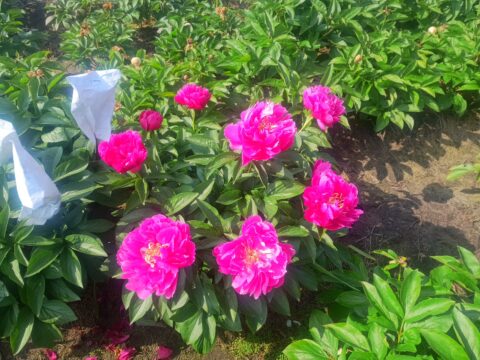
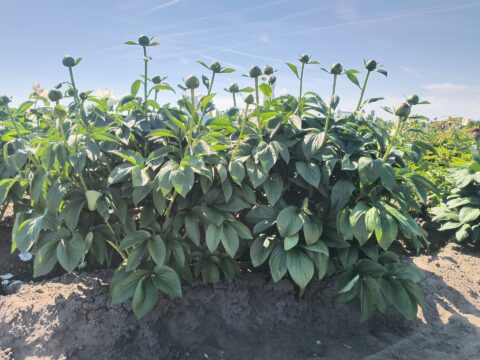
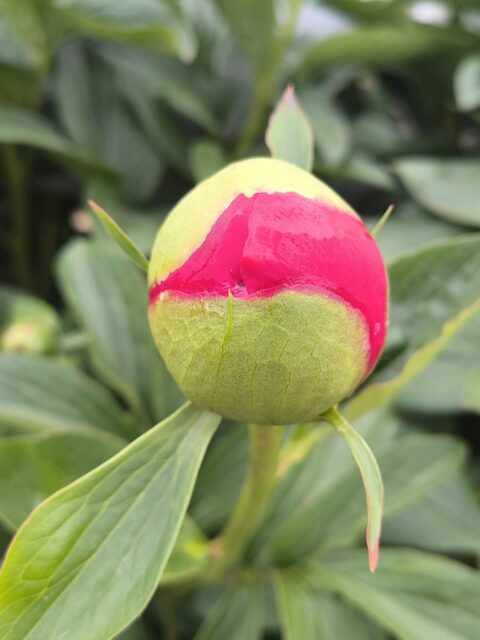
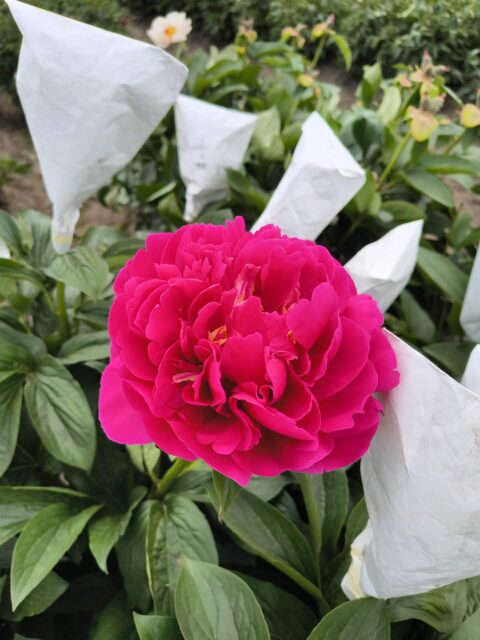
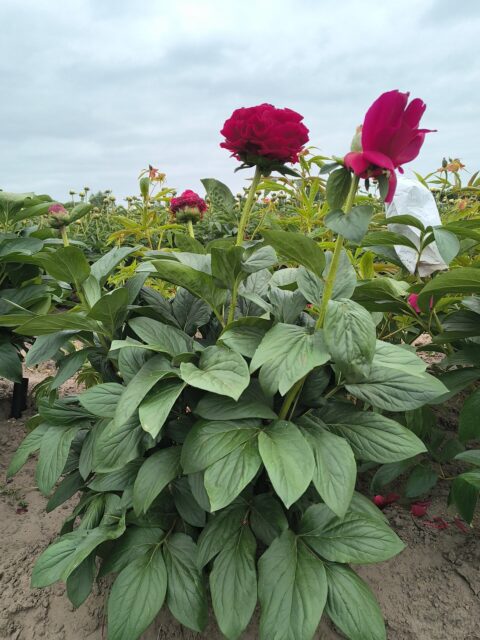
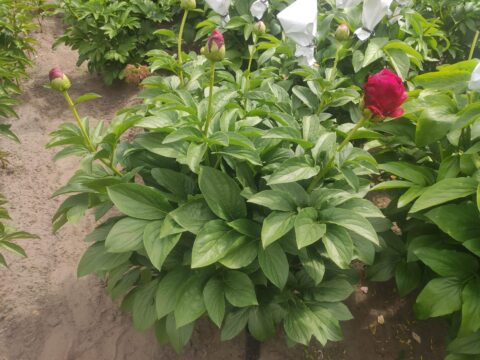
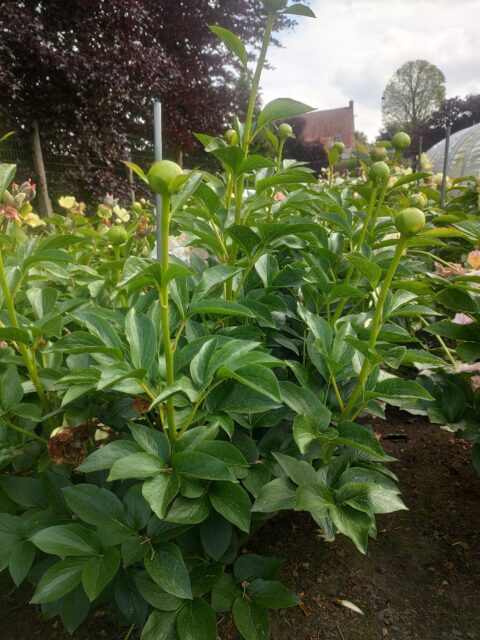
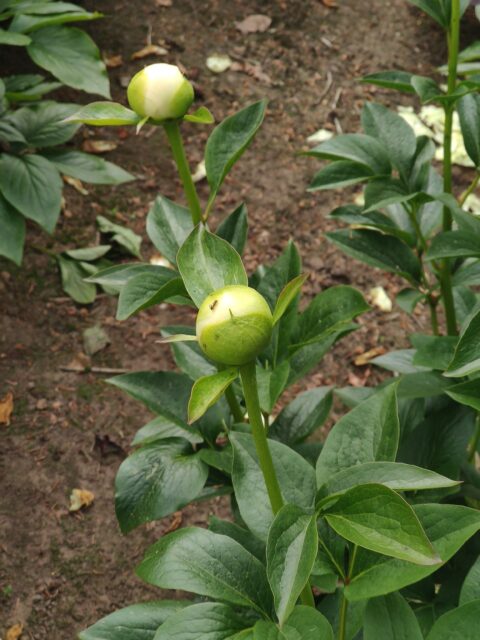
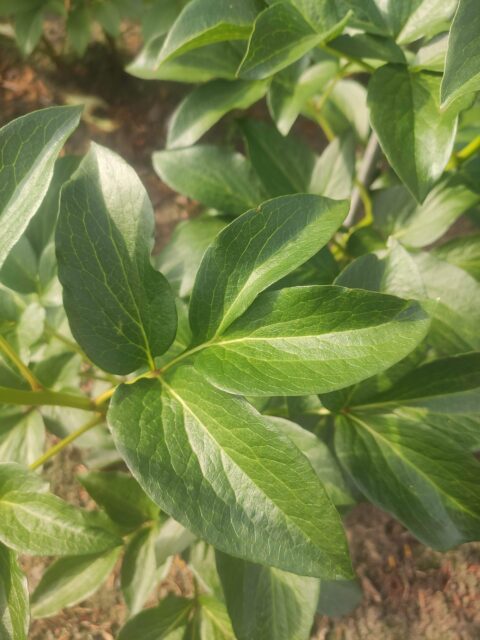
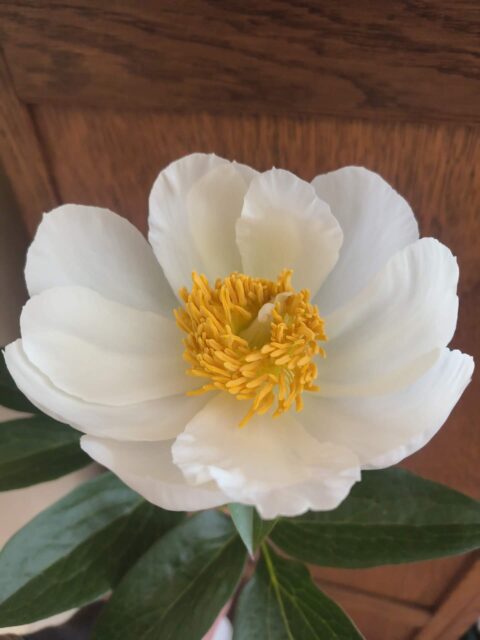
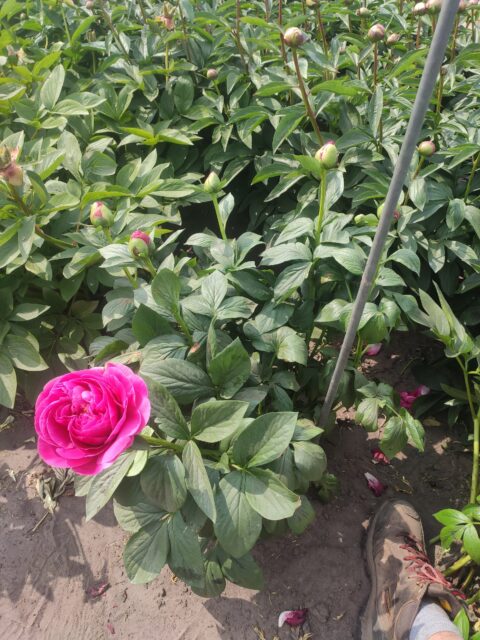
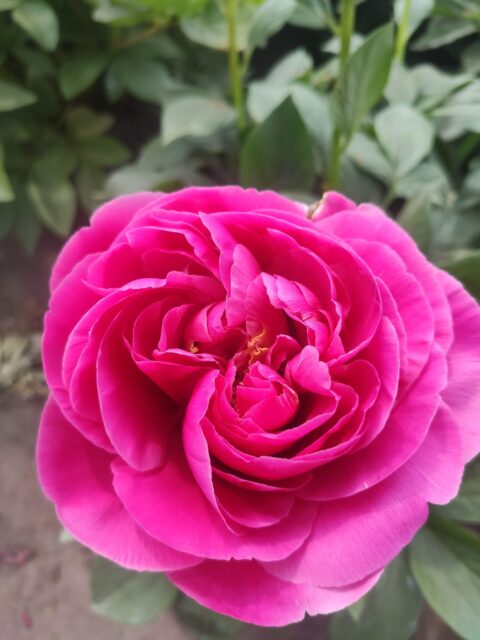
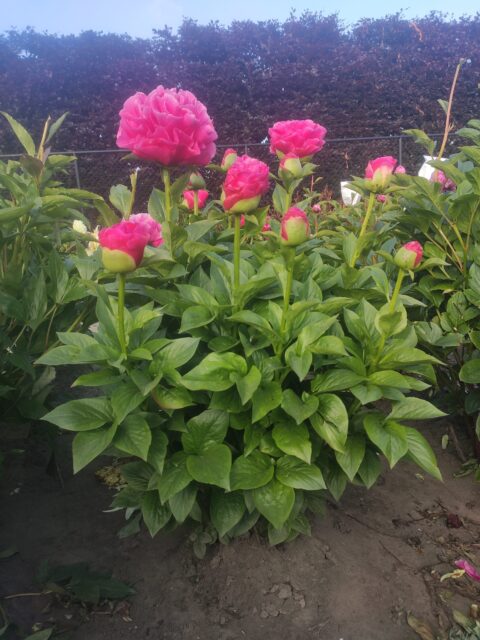
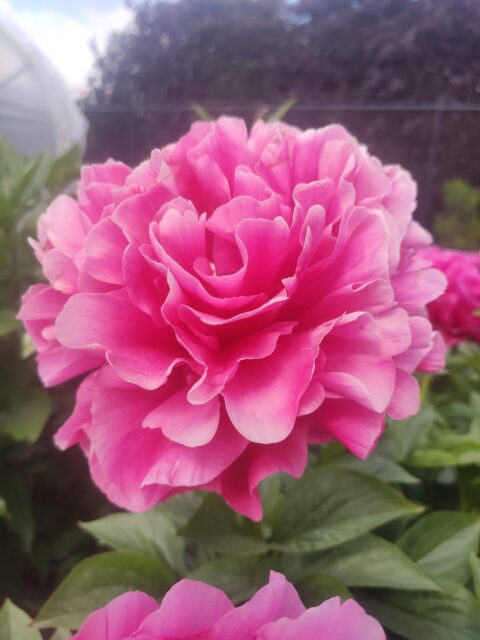
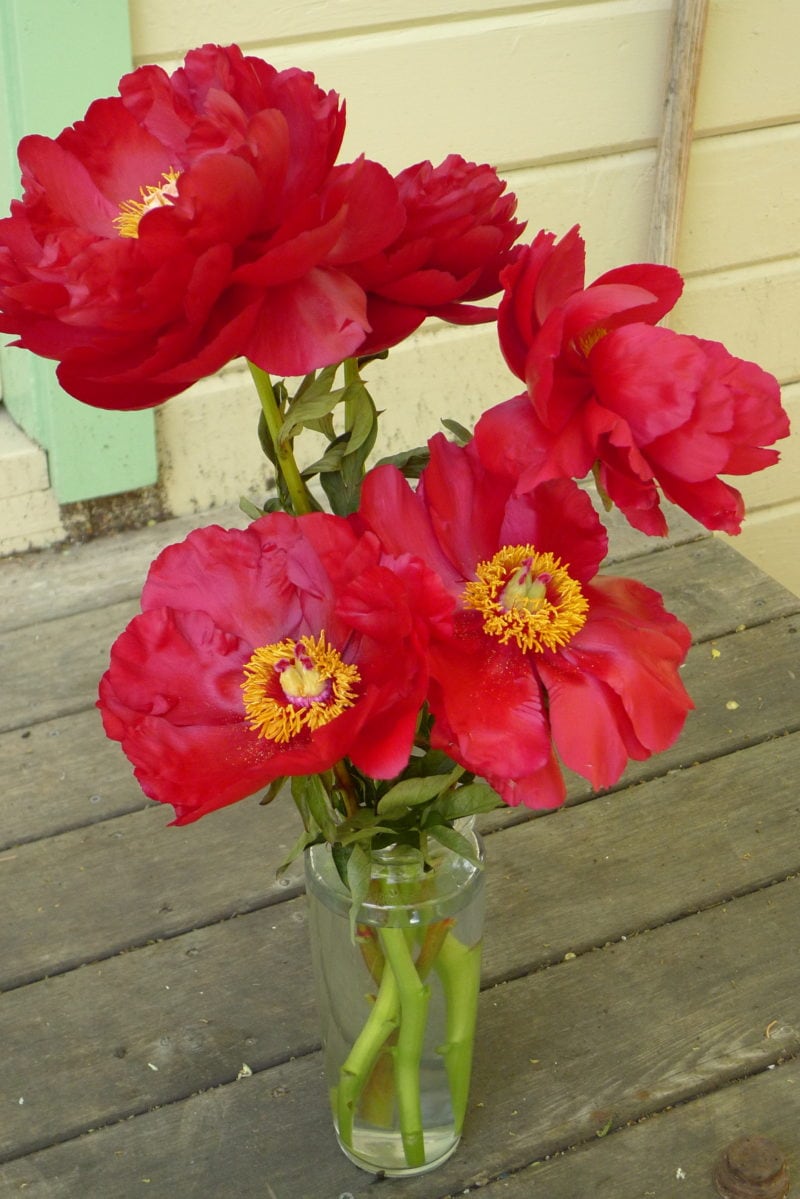
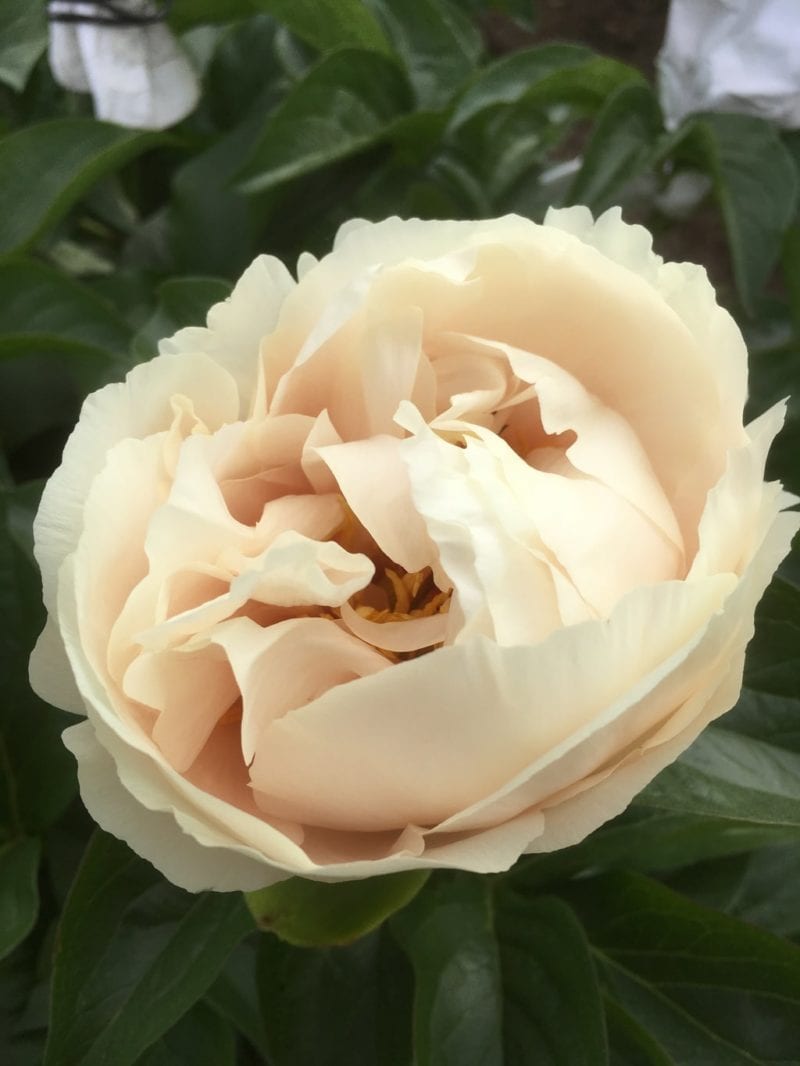
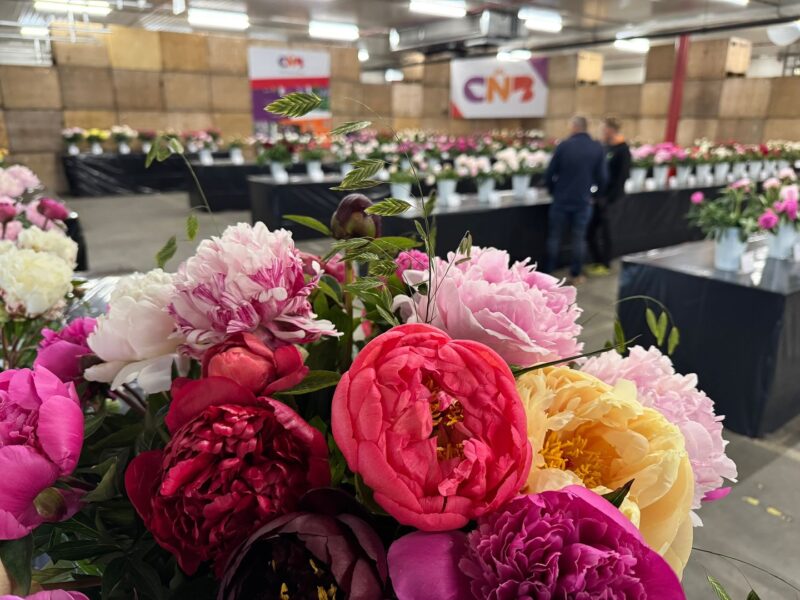

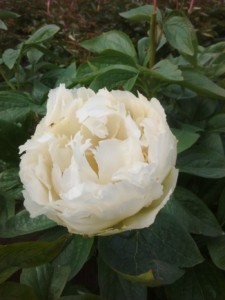

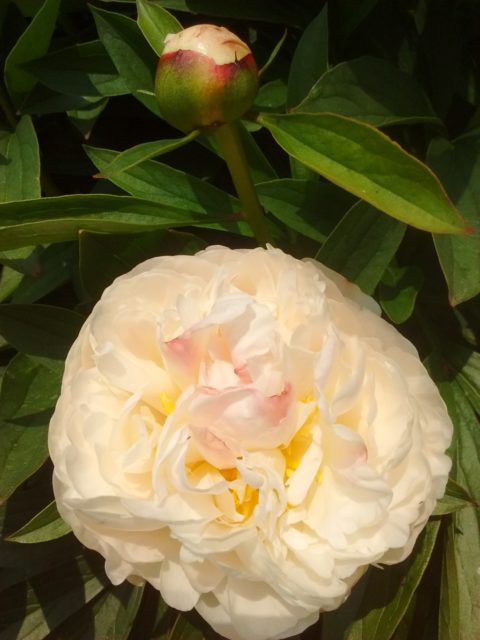

OF never makes good carpals at my house, so the method I used was to use OF as a pollen parent. Which means knowing a friend who lives somewhere where the season is much earlier than in my (quite late) area where I can get pollen, and then use it on earlier varieties.
You are right though; strong stems are the goal here, and in the long run I believe will be the ultimate goal of all work with the herbaceous hybrids, even if not all of our wonderful new varieties have them yet.
Bob